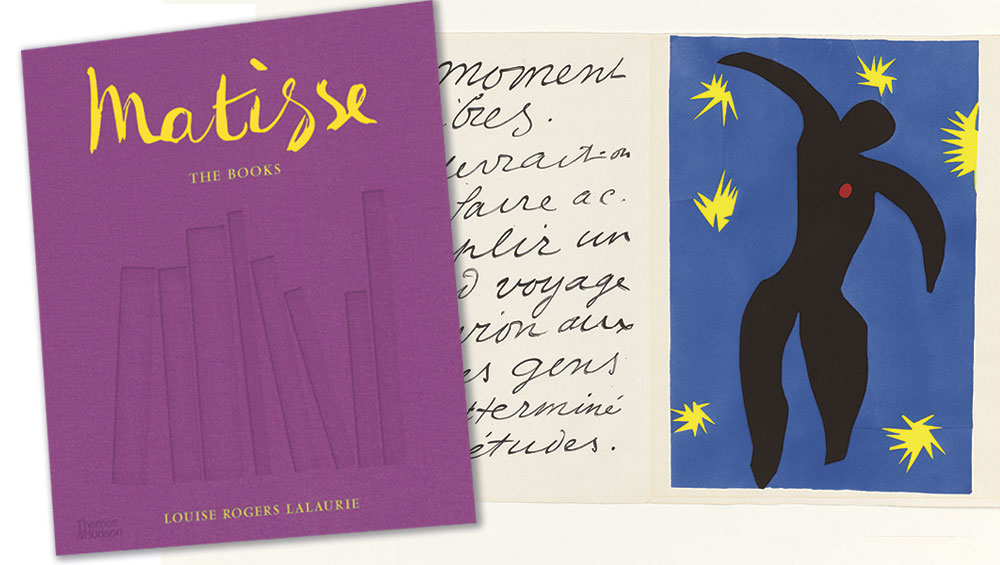
Reviewed by BETH WILLIAMSON
This is a book about books that brings us face to face with looking and reading. Artist’s books or livres d’artiste require both these things of us, and in the most sensitive of fashions. The books of Henri Matisse (1869–1954) coalesce in the period 1932 to 1950. For 18 years, Matisse weaved aspects of his physical suffering and personal upheaval into these books. Conflict in, and occupation of, France featured, too. The complex interweaving of themes in these books appears in just eight limited-edition volumes. Limited in number and expensive to purchase, the words and images of these books have been inaccessible to a wider audience until now.
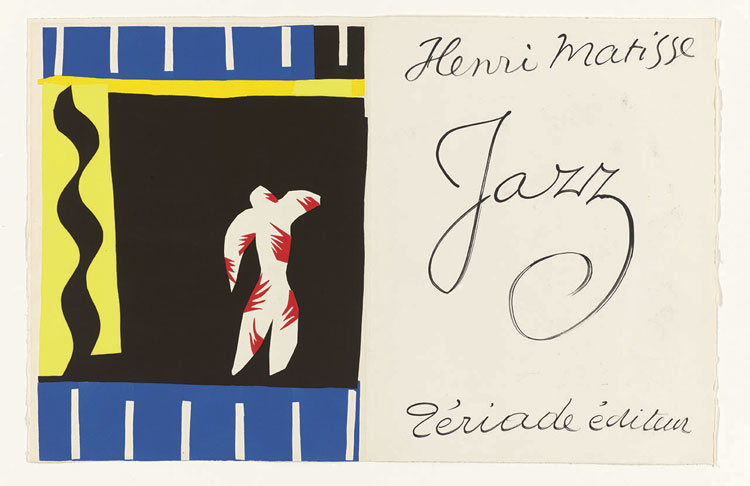
Jazz title-page spread, From: Jazz by Henri Matisse, 1947, published by Tériade, Paris, unbound book with colour stencils on Arches paper and lithographed text, 42.5 x 33 x 3.5 cm. (Matisse: The Books by Louise Rogers Lalaurie, p260). Photo: Philadelphia Museum of Art. Purchased with the John D. McIlhenny Fund, 1948. Photo © Philadelphia Museum of Art. Artwork © Succession H. Matisse/DACS 2020.
Author Louise Rogers Lalaurie’s publication aims to make Matisses’s books accessible in a manner that brings significant themes to the fore. Matisse’s politics is just one of the matters to emerge, alongside the big themes of truth and beauty, faith and ageing, loss and relationships. Lalaurie sets out the eight rare books in a logical way. Word and image become available, not reified, and new contexts and narratives surface. This is a sumptuous publication from the outset, with its deep-purple cloth covers embossed with golden lettering and generously illustrated within. Each of Matisse’s books is addressed in a dedicated chapter that considers its development from the date of its inception until its publication. Through his close collaboration with literary and poetic voices, Matisse developed powerful publications that, as Lalaurie points out (on page 9 of her book), were and remain “erotic, romantic, nostalgic and decorative”. In 1948, Louis Aragon summed up their importance:
Mallarmé, Baudelaire, the Portuguese nun … the cycle of books that Henri Matisse dreamed – for what distant lock, far back in time, was he searching? Over 18 years, renewing the very concept of illustration, this great painter, in his major books, invariably identified with an aspect of his text … Entirely, as if, in his later years, Henri Matisse used books to tell the story of his life. (See page 9 again).
Lalaurie examines one book at a time with each individual chapter laid out in a similar form. Every chapter begins with the book cover or wrap, the title spread and/or selected images. Illustrations are reproduced in their original sequence. This lends continuity to her publication and gives the reader a familiar framework within which to think about each of the eight books, useful when what is being suggested is a number of fundamental themes that stretch across and through all eight. They are presented in order of creation, which lends a chronological logic to the publication, too. With the exception of Poésies de Stéphane Mallarmé, all the books were created during the second world war.
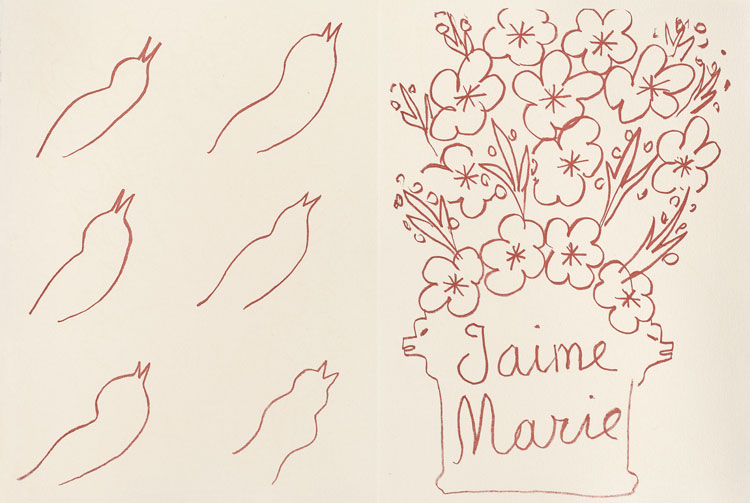
J’aime Marie, from: Florilège des Amours de Ronsard by Pierre de Ronsard, 1948, published by Albert Skira, Paris, unbound book with lithographs in sanguine on Arches wove paper; loose in wrappers, lithograph by Matisse on the cover with the title in black; chemise boards covered in white paper, spine covered in purple suede with the author's name in purple on the spine; slipcase covered with white paper and decorated with a leaf motif (in blue), 38.5 × 29.3 × 4.4 cm. (Matisse: The Books by Louise Rogers Lalaurie, pp134-5). Photo: Fine Arts Museums of San Francisco. Gift of the Reva and David Logan Foundation. Photo © Fine Arts Museums of San Francisco. Artwork © Succession H. Matisse/DACS 2020.
Poésies de Stéphane Mallarmé (1930–32) is a book in a box collection of more than 50 poems by Mallarmé (1842–98). The graphic lines of Matisse’s accompanying illustrations may be sparse, but their curves and swells reflect the metre and rhythm of Mallarmé’s text. Commissioned in 1930 by Albert Skira, there are shifts in scale and rhythm throughout as Matisse moves from full-page etchings to smaller head- and tail-pieces. There is, according to the scholar Walter Strachan, a meticulousness about where Matisse places each line and his economy of line acts as a syntax of sorts to help us navigate the surrounding white space on the page.
Dessins, thèmes et variations (1941–43), begun in 1941 and printed in 1943, is a portfolio of 158 drawings by Matisse. Its wartime context and Louis Aragon’s preface are important for our understanding of this book. Arranged into themes and variations lettered A to P, Matisse’s images show sleeping, stretching, lounging women, or interiors filled with plants, fruit, soft furnishings and teapots.
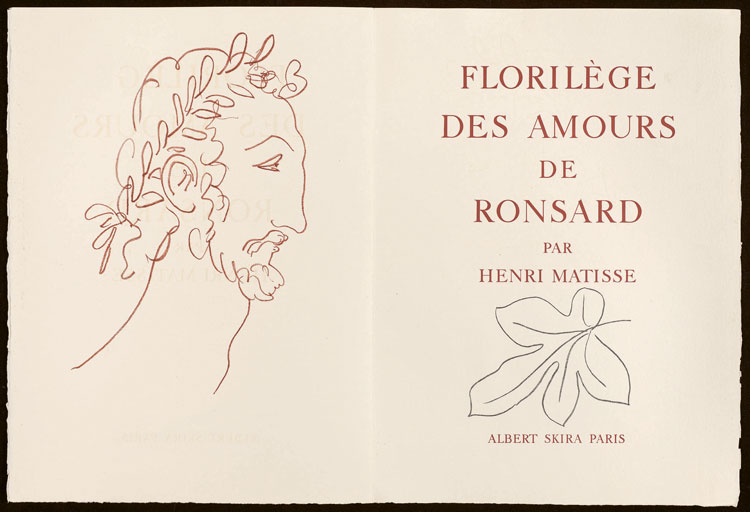
Florilège des Amours de Ronsard title-page spread, from: Florilège des Amours de Ronsard by Pierre de Ronsard, 1948, published by Albert Skira, Paris, unbound book with lithographs in sanguine on Arches wove paper; loose in wrappers, lithograph by Matisse on the cover with the title in black; chemise boards covered in white paper, spine covered in purple suede with the author's name in purple on the spine; slipcase covered with white paper and decorated with a leaf motif (in blue), 38.5 × 29.3 × 4.4 cm. (Matisse: The Books by Louise Rogers Lalaurie, pp104-5). Photo: Fine Arts Museums of San Francisco. Gift of the Reva and David Logan Foundation. Photos © Fine Arts Museums of San Francisco. Artwork © Succession H. Matisse/DACS 2020.
The next book, Florilège des amours de Ronsard (1941-48) consists of 126 lithographic prints that illustrate the love poetry of the 16th-century French poet Pierre de Ronsard. Begun in 1941, it was finally published in 1948. The fine lines seen in Poesis are gone and images are cruder than in previous books, with a heavy pressure required in the printing.
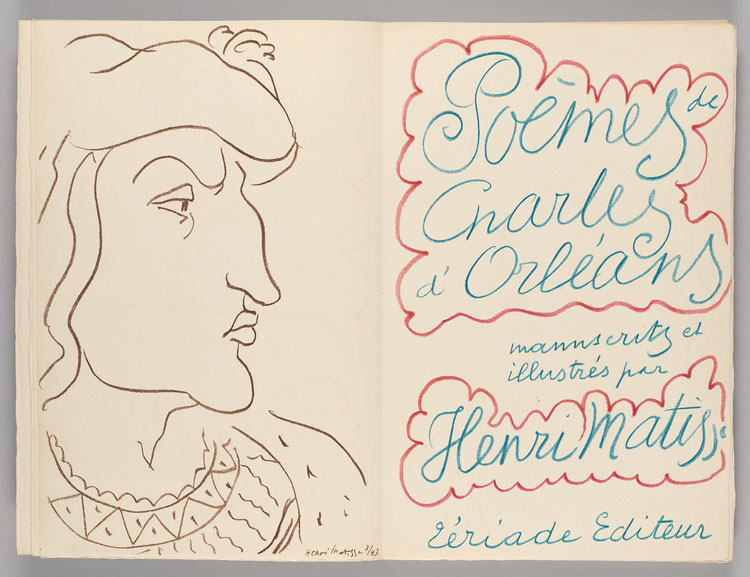
Poèmes de Charles d’Orléans title-page spread, from Poèmes de Charles d’Orléans, by Charles d’Orléans, 1950, published by Tériade, Paris, colour lithograph on Arches paper, 41.4 x 27.8 cm. (Matisse: The Books by Louise Rogers Lalaurie, pp144-5). Photo: Harvard Art Museums/Fogg Museum. Gift of Mrs Howard J. Sachs in memory of Howard J. Sachs. Photo © President and Fellows of Harvard College. Artwork © Succession H. Matisse/DACS 2020.
Matisse wrote by hand and illuminated the Poèmes de Charles D’Orléans (1942–50). The 40 poems are written in black ink and retain their Old French spelling. The multicoloured crayon decorations, including scrolled cartouches and fleur-de-lys, were difficult to print, which partly explains the lengthy production and printing time for this book.
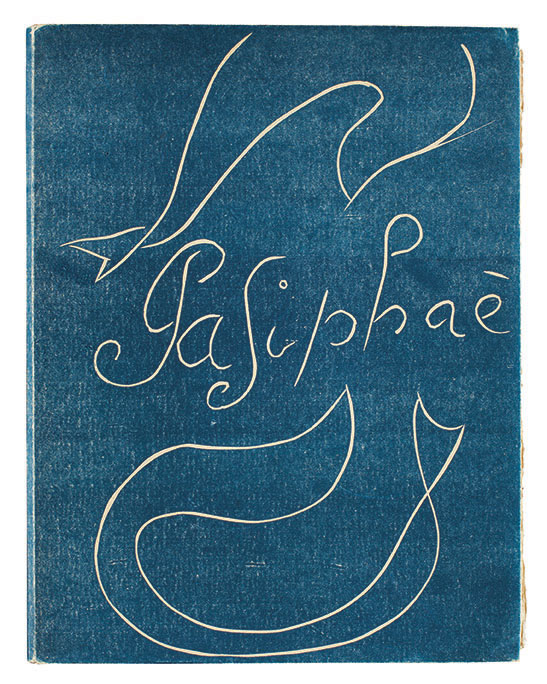
Pasiphaé: Chant de Minos cover, from Pasiphaé: Chant de Minos (Les Crétois), by Henry de Montherlant, 1944, published by Fabiani, Paris, unbound book with linoleum cuts on cream wove paper, 33.7 x 25.6 x 4 cm. (Matisse: The Books by Louise Rogers Lalaurie, p172). Photo: Toledo Museum of Art, Ohio. Gift of Molly and Walter Bareiss. Photo © Toledo Museum of Art. Artwork © Succession H. Matisse/DACS 2020
Pasiphaé, Chant de Minos (1943-44) was begun in 1943 and printed in Paris in May 1944, just two weeks before the D-Day landings. It is a very different book from those that came before. Gone is the airy white space of the page and, instead, Matisse’s graphic lines and patterns are set on a black background to produce darkly bold images.
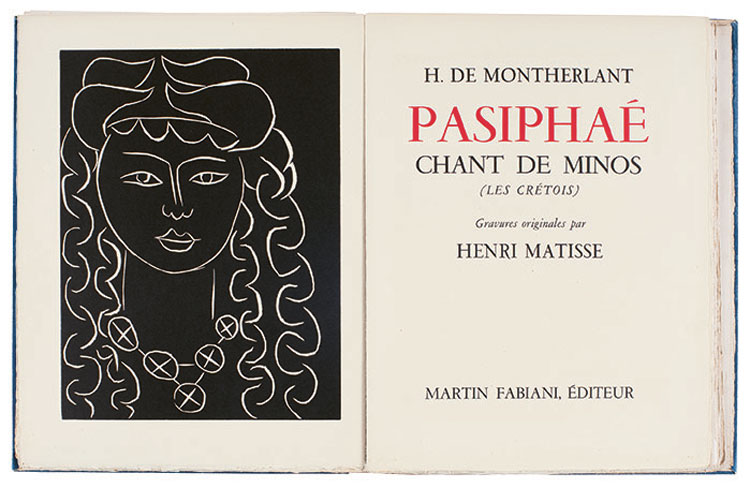
Pasiphaé: Chant de Minos title-page spread, from Pasiphaé: Chant de Minos (Les Crétois), by Henry de Montherlant, 1944, published by Fabiani, Paris, unbound book with linoleum cuts on cream wove paper, 33.7 x 25.6 x 4 cm. (Matisse: The Books by Louise Rogers Lalaurie, pp174-5). Photo: Toledo Museum of Art, Ohio. Gift of Molly and Walter Bareiss. Photo © Toledo Museum of Art. Artwork © Succession H. Matisse/DACS 2020
In Les Fleurs du Mal (1939–47), Matisse selected 31 poems from 152 in the 1868 edition of the same name by Charles Baudelaire (1821–67). The portraits and arabesques sweep through the pages and Matisse’s expressive heads’ embody the words of Baudelaire’s poems. Next, Lettres Portugaises (1945–46) refers to the passionate letters published in 1669, and largely written by a Portuguese nun, Mariana Alcoforado (1640–1723), to her former lover. Finally, Jazz (1941–47) is perhaps Matisse’s best-known book. The brightly coloured collages and cut-outs are bold and joyous. From lagoons to circus acts, magenta, crimson and verdant green leap off each page.
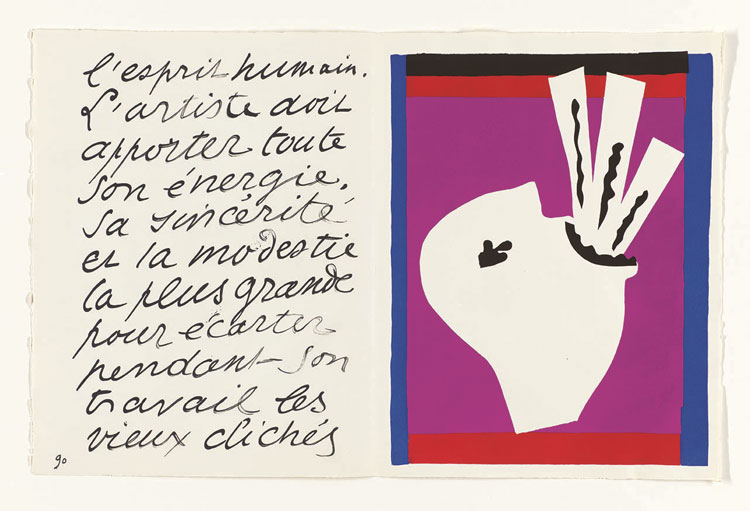
Jazz, From: Jazz by Henri Matisse, 1947, published by Tériade, Paris, unbound book with colour stencils on Arches paper and lithographed text, 42.5 x 33 x 3.5 cm. (Matisse: The Books by Louise Rogers Lalaurie, pp261-2). Photo: Philadelphia Museum of Art. Purchased with the John D. McIlhenny Fund, 1948. Photo © Philadelphia Museum of Art. Artwork © Succession H. Matisse/DACS 2020.
Lalaurie’s idea in this publication is to offer the reader something akin to the experience of reading the original livres d’artiste for themselves, to convey a sense of handling them as books. While it is good to see at least some of the images in sequence, I cannot honestly say that anything approaching the true experience of handling is achieved here, but something that makes the contents of such rare livres d’artiste more accessible has to be welcomed. What I do appreciate is the attention given to the production details of each book, which press they were printed on and where, the number of copies made, the particular paper used, the typography, the name of the master printer. We are even told whether the stones or plates were destroyed afterwards. It is these sorts of material facts that I think give a sense of the look and feel of the books more than anything else. The sheer number of images reproduced in sequence and the contextual detail given is much appreciated too in a publication that ultimately brings us closer to Matisse and his books.
• Matisse: The Books, by Louise Rogers Lalaurie, is published by Thames & Hudson on 24 September 2020, price £65.
• The related exhibition, Matisse, Comme un Roman, will be on view at the Centre Pompidou, Paris, from 21 October 2020 to 22 February 2021.